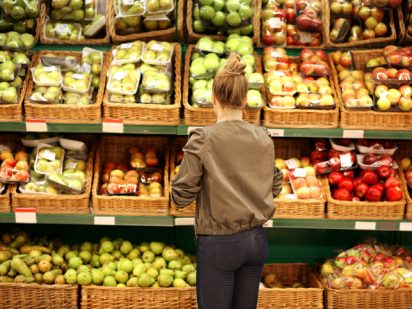By Michelle Gleason, RDN, LRD
Juicy watermelon, sweet pineapple, and savory tomatoes are just some of the fresh fruits and vegetables that many of us look forward to during the summer months. Although most fruits and vegetables look nice in the grocery store, it can be difficult to choose the best tasting produce.
Has anyone else cut up a pineapple and found that it has a woody taste to it? Fruits and vegetables need to undergo ripening before they taste their best. During ripening, starches break down into sugars and the fruit softens, often changes color, and turns sweeter. For those who prefer to shop less frequently, choosing produce at different levels of ripeness can help with meal planning throughout the week.
Try some of these tips for choosing ripe fruits and vegetables:
Avocado:
Ripe avocados have dark brown skin with a slight green tint. They should be firm, but have some give when gently squeezed. Pull out the remaining stem and see what color is underneath: green = under ripe, light brown = ripe, and dark brown = overripe. Avocados only ripen after being picked.
Banana:
A ripe banana is yellow all over with a few brown spots, though some people may prefer different levels of ripeness. Purchase smaller bunches as bananas will continue to ripen after they are picked. To speed up ripening, place bananas in a brown paper bag with an apple, tomato, or pear and keep in a warm spot. These fruits give off ethylene gas, which speeds up ripening. To slow down ripening, separate bananas from the bunch and store them in different areas of the kitchen.
Cantaloupe:
Ripe cantaloupe should feel heavy, firm, and have a low, solid sound when knocked. The blossom end (opposite of the stem end) will have a sweet aroma. Avoid fruit with dents, mushy spots, and those with the stem still attached. Cantaloupes will continue to ripen after they are picked and it’s best to let the fruit ripen before cutting it up. Cut cantaloupe is very appealing to bacteria, so store this fruit in the fridge.
Corn on the cob:
Look for corn with a tightly wrapped, green husk. Peel some of the husk back and look for plump white or yellow kernels. Kernels should be tender and have a milky fluid inside. Look for silky, somewhat sticky tassels.
Peach:
A ripe peach is juicy, has a sweet aroma, and is firm with some give when gently squeezed. Look for peaches that are all red and yellow with no green. To help ripen at home, lay the peach on its side and keep out of direct sunlight. To slow ripening, place the peach in the fridge.
Pineapple:
Pineapples become heavier as they ripen. Compare similar sized pineapples and choose the heavier one. Pineapples ripen from the bottom (stem end) and slowly turn golden yellow up toward the leaves. A pineapple may be ripe even if it still green near the top. Look for healthy, green leaves. If leaves are easily plucked out, the fruit may be overripe. Choose pineapple with spikes close to the fruit (not sticking out) and a sweet aroma at the stem end. Pineapples will not continue to ripen after they have been picked.
Tomato:
Tomatoes have best flavor when they allowed to ripen on the vine. Some varieties of tomatoes are yellow, orange, or even purple when ripe. Look for smooth, shiny, firm skin and an earthy smell at the stem. To speed up ripening, place in a brown paper bag with a banana. Ripe tomatoes can be refrigerated, but they taste best at room temperature.
Watermelon:
To choose a ripe watermelon, knock on the fruit and listen for a hollow sound. Look for a melon with a dark yellow field spot (where the fruit was resting on the ground) rather than a white field spot. Choose a watermelon with a dull surface, as shiny watermelons are often under ripe. Watermelon will not continue to ripen after it is picked.
Michelle Gleason, RND, LRD, is a clinical dietitian with Trinity Health.




